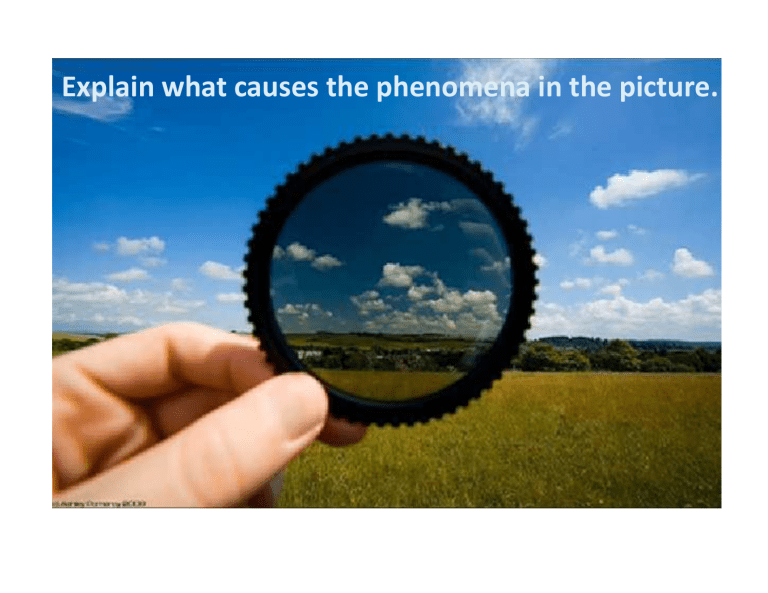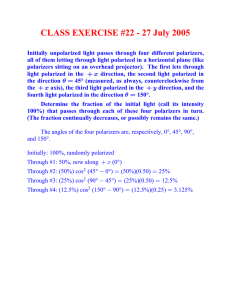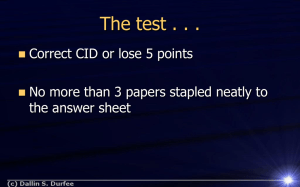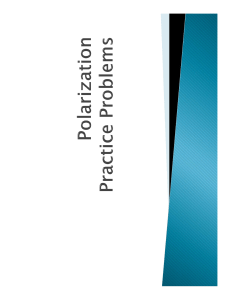
Explain what causes the phenomena in the picture. Polarization What kind of waves can be polarized? • All transverse waves such as – Wave in string – Light • Plane polarized: wave is always in a single fixed plane • This string wave is vertically polarized; it can pass through a vertical “filter” but not a horizontal one Light waves are transverse waves • Light consists of perpendicular oscillating electric and magnetic fields • We can concentrate on the electric field in this discussion since it is the one our eyes perceive Polarizing Light by Absorption • Unpolarized light has electric fields in all directions • Passing unpolarized light through a filter reduces its intensity by 50% Polarization by Transmission • What happens when polarized light is passed through additional filters? • According to Malus’s Law: I = I0cos2 θ where I = transmitted intensity I0 = incident intensity θ = angle between e-field and filter’s transmission axis Malus’ Law Applet http://www.lon-capa.org/~mmp/kap24/polarizers/Polarizer.htm Polarizers and Analyzers • Polarizer: a polarizing filter used to produce polarized light • Analyzer: a polarizing filter used to determine if light is polarized • Unpolarized light’s intensity is reduced by 50% when passing through a polarizer/analyzer regardless of the orientation of the polarizer/analyzer • Already polarized light’s intensity is reduced depending on orientation of polarizer/analyzer according to Malus’s Law Polarization by Reflection When unpolarized light reflects off a nonmetallic surface, the reflected ray is partially polarized Plane of polarization is parallel to the reflecting surface Brewster’s Angle • At a particular incident angle the reflected ray is 100% polarized along plane parallel to surface • This occurs when angle between reflected and refracted rays is 90° • Applying Snell’s Law: n1 sin θp = n2 sin (90°- θp) = n2 cos (θp) tan θp = n2/n1 tan ϕ = n Brewster’s Angle Video • https://www.youtube.com/watch?v=ExVbUdD zEKg • Note: This same David Brewster also invented the kaleidoscope! Optical Activity • Optical activity is the rotation of the plane of polarization • Materials showing this phenomenon are called optically active – Sugar solutions – Tartaric acid – Turpentine – Quartz crystals – Liquid crystals • Used in – Measuring solution concentrations – Liquid crystal displays A Liquid Crystal Display 1. Polarizing filter 3. Twisted liquid crystal 5. Polarizing filter 2. Glass with shaped electrodes 4. Glass with common electrode film 6. Reflective surface Polarimeter: used to determine conc. of optically active substances How Polarimeter Works Amount of rotation depends on (1) length of sample tube and (2) solution concentration Some compounds rotate the polarized light to the right (dextrorotary), others to the left (levorotary) Homemade Polarizers • http://www.youtube.com/watch?v=HP14LAEy 9BY • http://www.youtube.com/watch?v=CJS6CwL2 eQU&NR=1 Stress analysis using polarizers







